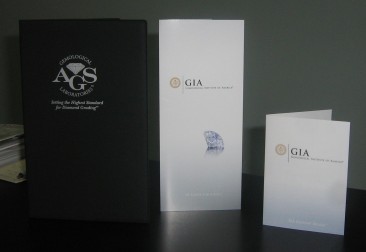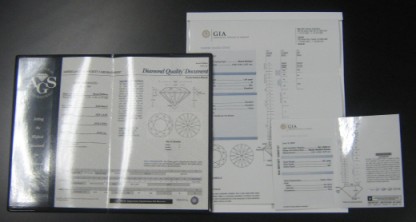When most people compare GIA to AGS certificates, they immediately think about the grading – that is, the differences in how they grade colour, clarity and cut.
Whilst they are two of the most consistent and accurate labs in the world, what some people don’t know is that the actual physical presentation of the certificates vary greatly, as show below.


As you can see, the GIA certificate is merely a laminated piece of plastic, whilst the AGS certificate is presented in a vinyl folder.
August 21st, 2007 at 4:42 pm
GIA Sued Over Grade Dispute
A former Harry Winston employee has sued Vivid Collection and the Gemological Institute of America over two diamonds that he charges were misrepresented in their grades. In perhaps its most eyebrow-raising allegation, the suit claims that “payments were made” to GIA to have the two stones “upgraded.”
GIA told JCK it “vigorously denies the allegations.” It has filed a motion to dismiss the suit, which argues that statements regarding the color and clarity grades are “statements of opinion.”
The suit, filed in the Supreme Court of the State of New York this April, charges that in 2001, dealer Max Pincione purchased two pieces of jewelry from Vivid: a platinum diamond ring with a 37.01 ct. stone and a 103.78 ct. pear-shape pendant. According to the lawsuit, the pieces had reports labeling them as H/VS2 and D Flawless, respectively.
The plaintiff then sold the diamond ring to the Saudi royal family. “After the sale was made, and the stone was examined by independent experts of the Royal Family of Saudi Arabia, the diamond ring was returned to the plaintiff without explanation, and with a demand for the return of the monies paid for the stones,” the suit said.
Pincione then sold the pendant to a Saudi entrepreneur. Again, the diamond was returned to the plaintiff. “The plaintiff later was advised that the stones were not of quality stated in the GIA grading reports … and thus the plaintiff lost both the Saudi Royal Family and Saudi entrepreneur as clients,” the suit says. This caused the defendants to risk “incarceration and punishment in Saudi Arabia,” the suit says. For harm to his business reputation, Pincione seeks $50 million.
The suit includes an “Exhibit F” that it says “indicates that payments were made by the defendant Vivid to defendant GIA to ‘upgrade’ the quality of the diamonds sold to the plaintiff.” The document shown, however, is a page of handwritten numbers and letters. Pincione’s attorney said the page shows several payoffs—not just the two alleged in the suit—and will be backed up in court by oral testimony.
In its motion to dismiss, GIA’s lawyers noted the “important limitations” listed on the back of its reports, which says that GIA “has made no representation or warranty regarding the Report … the results of any other examination performed on the diamond may differ … this report may not be referred to as a guarantee, valuation, or an appraisal.” It also noted that GIA never dealt directly with Pincione, thereby undermining the suit’s legal standing.
Vivid Collection declined comment, but noted that it has also filed a motion to dismiss. Pincione declined comment. He has replaced his first legal team. His new lawyer, Stephen Hans, says that he is filing an “amended complaint” to the court.
August 21st, 2007 at 5:40 pm
NY Times Reports GIA Scandal, Suit in Settlement Negotiations
Max Pincione, the diamond dealer who sued the Gemological Institute of America (GIA) and Vivid Collection over alleged payments in return for issuing upgraded reports for two diamonds, is negotiating a settlement with the institute, according to a report in The New York Times. This is the first time a media outlet outside the diamond industry has reported on the GIA Certifigate scandal.
The New York Times, reporting the story today (Tuesday) in the New York Region section of the paper, also reports that Federal prosecutors are “gathering information about a bribery scandal.” The GIA said that in the past it gave U.S. authorities information it gathered in an internally conducted investigation.
According to eyewitnesses, FBI agents have visited the GIA lab in Manhattan since the scandal broke.
The newspaper quotes new GIA chairman Ralph Destino, individuals at the New York Diamond Dealers Club and a spokeswoman for the United States attorney’s office in Manhattan, making the first public report by the mainstream media. It is unclear what kind of effect the report will have on consumer purchasing behavior.
According to the report, Pincione’s lawyer, Joseph Tacopina, declined to discuss the case with the newspaper because he was negotiating a settlement with the institute. In April, Pincione started a whirlwind that sent a tremble through the industry when he sued the GIA.
The $50 million in damages suit, resulted in an internal GIA investigation, the firing of four employees, the resignation of the lab’s CEO Tom Yonelunas, the ending of Rapaport’s exclusive arrangements, an overhaul in donation policies and cancellation of membership pricing.
In the suit, Pincione said he bought a platinum diamond ring with a 37.01 carat diamond, and 103.78 carat pear shaped pendant from jewelry designer Vivid Collection in 2001. The two diamonds were GIA certified: The 37.01 carat diamond as H / VS2 and the 103.78 carat pendent diamond as D / Flawless.
According to the complaint, Pincione sold the diamond ring to the Royal Family of Saudi Arabia. But then, he alleges, “After the sale was made, and the stone was examined by independent experts of the Royal family of Saudi Arabia, the diamond ring was returned to the plaintiff without explanation, and with a demand for the return of the monies paid for the stones.”
The same happened with the pendant, which was sold to a Saudi businessman and then returned on the same grounds – that the stone was not of the “quality stated in the GIA grading reports.”
The GIA announced following the internal investigation that “a handful” of clients were involved in the scandal, but never released their names.
June 22nd, 2008 at 6:43 pm
[…] Print prettier certificates. The better looking the certificate, the better the lab right? Just don’t try to compete with the AGS. […]